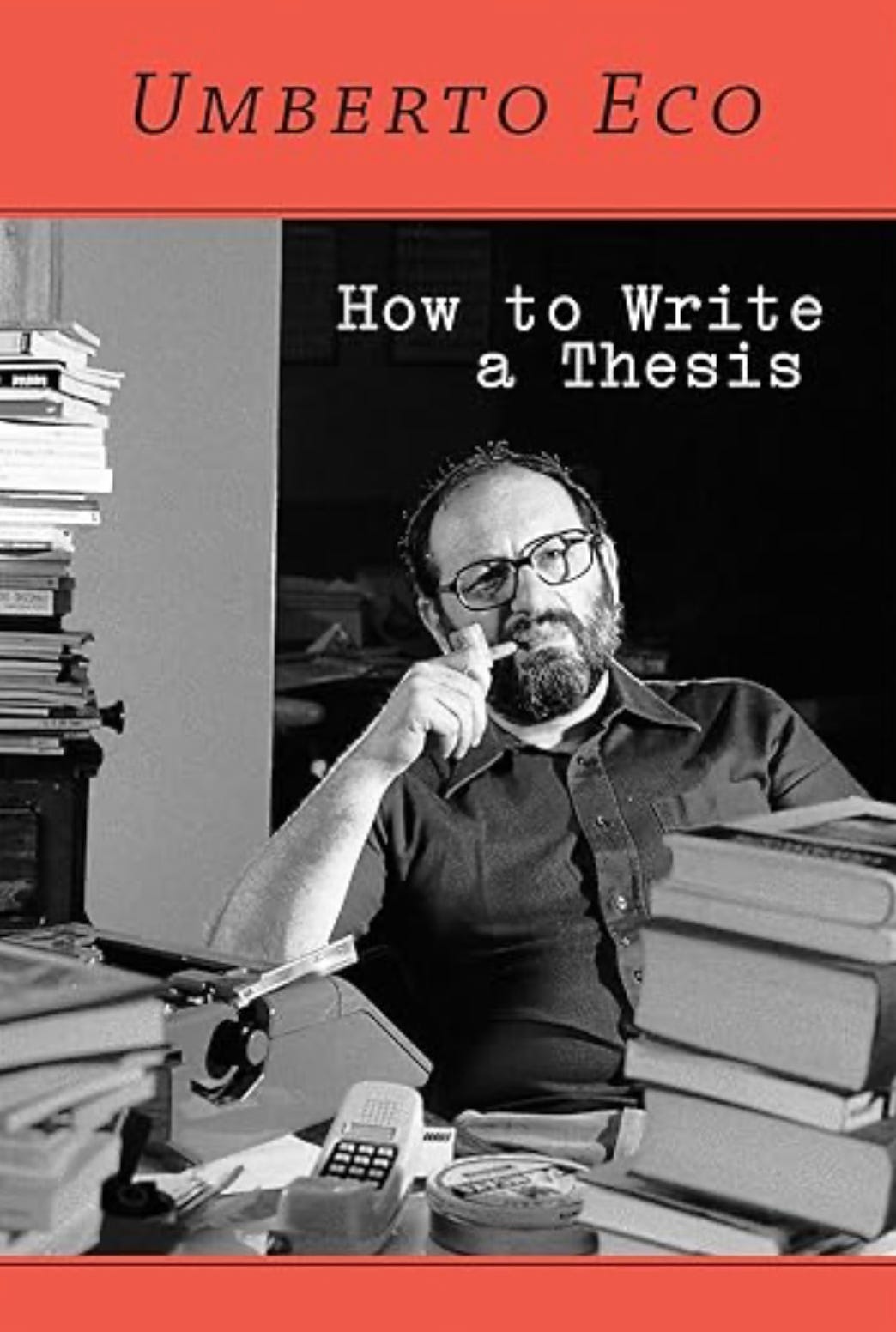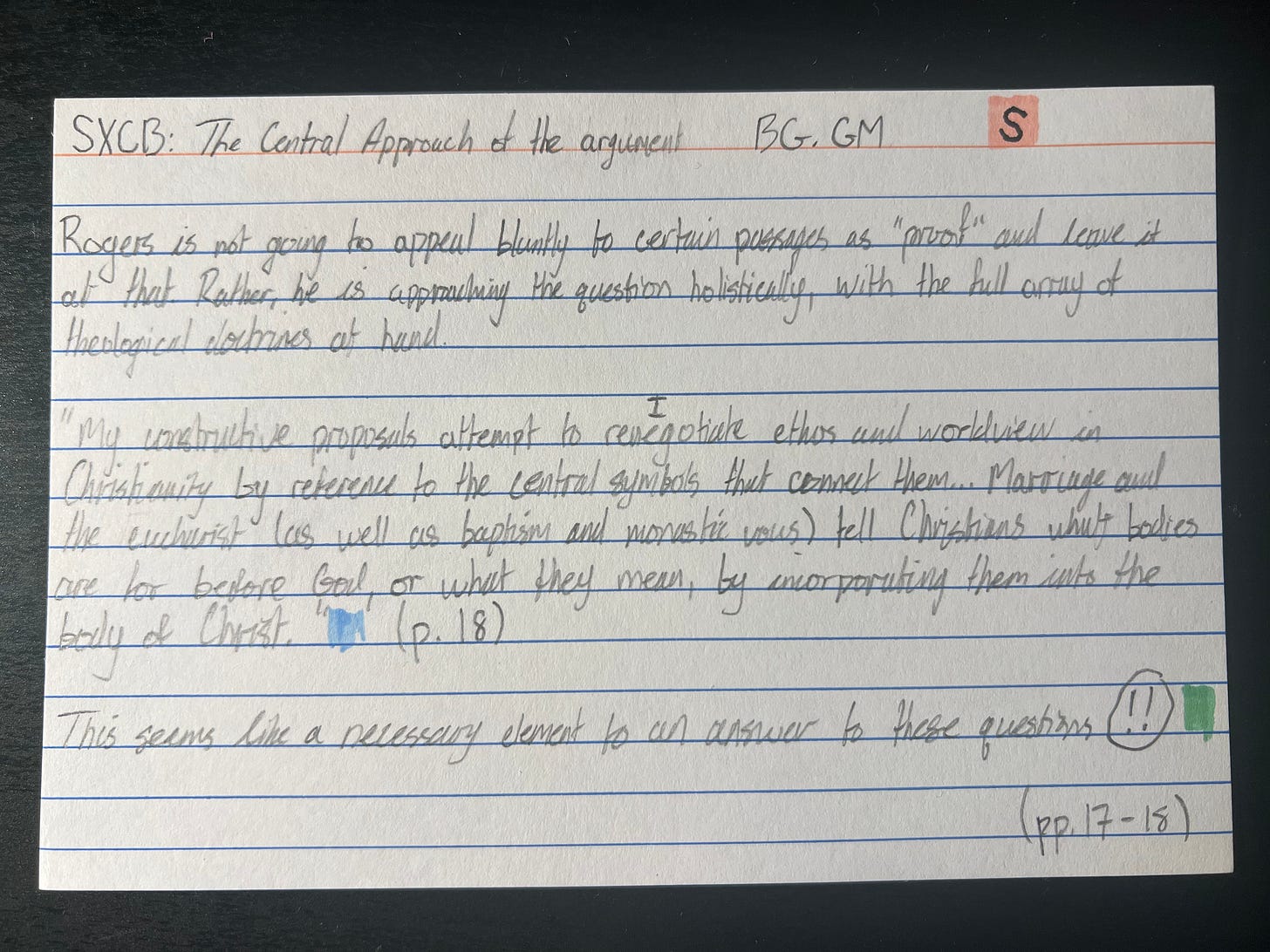How I take notes
Research is hard. Really hard. It is imperative, therefore, to have an excellent note-taking system when doing research, in particular in the humanities. I am not a student of humanities by day – my “day job” is getting a math degree – which meant my sexuality reading project requires all the more that I have systems in place. (You can see the first fruits of this system here.)
A friend, Bryce Allen (whose substack you all should subscribe to), recommended a couple books before I began the reading project. Yes, I read1 books about how to read books. Sue me! The two I picked up were The Craft of Research, published by the University of Chicago press, and Umberto Eco’s How to Write a Thesis. If you want Bryce’s explanation on why these books are so valuable, plus a surprise bonus third book,2 you’re in luck; he’s written an article all about it.
I skimmed The Craft of Research, and while it’s certainly valuable, I don’t need it quite yet. It’s a book I’ll have more use for when I start synthesizing things into a book properly. Eco, however…y’all. This man can write. Boy howdy can he write.3
My notecard system is, in essence, a modified version of the system Eco presents. Eco suggests several different types of cards. I have used most of his categories, as well as having a couple categories of my own:
Bibliography
Summary
Fact
Quote
Idea
Connection
Each card-type, following Eco, is marked front and back by a particular highlighter color. This makes it easy to see at a glance what sort of cards I have laid out. Additionally, each notecard will get a catalog reference. This is not so useful for me now, but will become integral as I approach thousands of notecards.
So, for example, the reference BG.TH.4 breaks down as follows:
BG: The reference for my sexuality project;4
TH: Theology;
4: Trinitarian doctrine.
In other words, a notecard with that heading will be about trinitarian doctrine in theology, and likely (but not necessarily) how it relates to sexuality. If, Lord willing, I manage to have a second big reading project in my lifetime,5 I will keep the topics and subtopics as they are labeled. So, there could easily be a card labeled AA.TH.4 in the future; this would be a different project, and likely be about how trinitarian doctrine in theology affects some other issue.
When making particular notecards, each card will also be labeled by what book/reference it comes from, and what the notecard is about. I use the colors in-line as well, to note where something of a different type is:
In this case, the book is SXCB, which is my abbreviation to Eugene Rogers’ Sexuality and the Christian Body. The notecard is from the sexuality reading project (BG), and is specifically on Gay Marriage (GM). It’s a summary, so it gets the salmon-y highlighter with an S in the corner. The primary purpose is to summarize what the overall approach of the book will be, as it pertains to his arguments. However, as you can see there are other colors on the card.
The blue is easily the most common in-line color; it allows me to easily spot quotes. So, if I’m looking for a particular quote that I can’t quite find, this gives me an easy first filter; I only have to look at quote cards, and cards with blue on them. The green is noting an idea; I think Rogers’ approach will be a necessary component of any solution to the questions I’m thinking about. And, of course, in the bottom right I’ve noted what pages this comes from.
This system, while still not truly fire-tested, has worked wonderfully so far. My article on Jennifer Cox’s book, Intersex in Christ, felt like it wrote itself because of the notecards.
The other thing I use is annotations; mostly written in books, occasionally (as above) on notecards. These are, for the most part, stolen directly from Chess.com’s annotations for chess moves.
I’m still figuring out how exactly I want to use them, but the most common ones are
(!!): Brilliant, excellent idea, and its weaker cousin, (!);
(?!): Dubious, interesting but doubtful;
(??): Blunder, terrible idea, crucial mistake;
(X): Mistake, factual error.
There’s others (I use “book” to denote things which are crucial for understanding the book at hand, for example) but the !! and ??-esque annotations get the most usage.
Your mileage may vary, of course, and I don’t think anyone should copy my format word-for-word. Play around with it, make the system yours. The system exists only to help you; if something doesn’t work, doesn’t help, don’t use it. And, really, you should buy Eco’s book anyway; there’s so much more advice and wit in there. I really can’t do it justice.
Which is, of course, the past tense of read. English is a silly language.
Rumor has it that there may be an even more surprising, bonus bonus fourth book. Who can say?
So far as I can tell, Eco was a living, breathing instantiation of (!!). This will make sense once you read further.
It is left as an exercise to the reader to try to guess what “BG” stands for in relation to the project. As a hint, it is indeed related to how I’ve named the project in my head. Comment below!
Something which I doubt more and more every day.









I haven’t read Eco’s book in its entirety, but I’ve been familiar with it for a long time. I’m also currently reading The Craft of Research. You gave me some things to think about and incorporate into my own notecard system. I just recently wrote a piece on how I take notes for research: https://open.substack.com/pub/thekeynote/p/the-lost-art-of-note-taking?r=2bujiq&utm_medium=ios
Looking forward to see what your note cards help you produce!